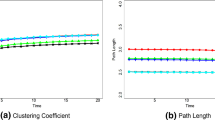Abstract
A social network is a social structure between actors (individuals, organization or other social entities) and indicates the ways in which they are connected through various social relationships like friendships, kinships, professional, academic etc. Usually, a social network represents a social community, like a club and its members or a city and its citizens etc. or a research group communicating over Internet. In seventies Leinhardt [1] first proposed the idea of representing a social community by a digraph. Later, this idea became popular among other research workers like, network designers, web-service application developers and e-learning modelers. It gave rise to a rapid proliferation of research work in the area of social network analysis. Some of the notable structural properties of a social network are connectedness between actors, reachability between a source and a target actor, reciprocity or pair-wise connection between actors with bi-directional links, centrality of actors or the important actors having high degree or more connections and finally the division of actors into sub-structures or cliques or strongly-connected components. The cycles present in a social network may even be nested [2, 3]. The formal definition of these structural properties will be provided in Sect. 8.2.1. The division of actors into cliques or sub-groups can be a very important factor for understanding a social structure, particularly the degree of cohesiveness in a community. The number, size, and connections among the sub-groups in a network are useful in understanding how the network, as a whole, is likely to behave.
Access this chapter
Tax calculation will be finalised at checkout
Purchases are for personal use only
Similar content being viewed by others
References
Leinhardt, S. (1977). Social networks: a developing paradigm. Academic Press, New York.
Rao, A.R. and Bandyopadhyay, S. (1987). Measures of reciprocity in a social network. Sankhya: The Indian Journal of Statistics, Series A, 49, 141–188.
Rao, A.R., Bandyopadhyay, S., Sinha, B.K., Bagchi, A., Jana, R., Chaudhuri, A. and Sen, D. (1998). Changing social relations – social network approach, Technical Report. Survey Research and Data Analysis Center, Indian Statistical Institute.
Mitra, S., Bagchi, A. and Bandyopadhyay, A.K. (2007). Design of a data model for social network applications. Journal of Database Management, 18, 4, 51–79.
Chen, L., Gupta, A. and Kurul, E.M. (2005). Efficient algorithms for pattern matching on directed acyclic graphs. IEEE ICDE.
Chakrabarti, S. (2004). Web mining. Elsevier.
Liben-Nowell, D. and Kleinberg, J. (2003). The link prediction problem for social networks. Proceedings of the ACM CIKM.
Newman, M.E.J. (2003). The structure and function of complex networks. SIAM Review, 45, 167–256.
Jin, E.M., Grivan, M., and Newman, M.E.J. (2001). The structure of growing social networks. Physics Review E, 64, 046132.
Barabasi, A. and Albert, R. (1999). Emergence of scaling in random networks. Science, 286, 509–512.
Kumar, R., Raghavan, P., Rajagopalan, S. and Tomkins, A. (2002). Web and social networks. IEEE Computer, 35(11), 32–36.
Flake, G.W., Lawrence, S.R., Giles, C.L. and Coetzee, F.M. (2002). Self-organization and identification of web communities. IEEE Computer, 35, 66–71.
Kleinberg, J.M. (2002). Small world phenomena and the dynamics of information. Proceedings of the 2001 Neural Information Processing Systems Conference, MIT Press, Cambridge, MA.
Watts, D.J., Dodds, P.S. and Newman, M.E.J. (2002). Identity and search in social networks. Science, 296, 1302–1305.
Bhanu Teja, C., Mitra, S., Bagchi, A. and Bandyopadhyay, A.K. (2007). Pre-processing and path normalization of a web graph used as a social network. Journal of Digital Information Management 5, 5, 262–275.
Salathe, M., May, M.R. and Bonhoeffer, S. (2005). The evolution of network topology by selective removal. Journal of Royal Society Interface, 2, 533–536.
Krapivsky, P.L. and Redner, S. (2002). A statistical physics perspective on web growth. Computer Networks, 39, 261–276.
Dorogovtsev, S. and Mendes, J. (2002). Evolution of networks. Advances in Physics, 51, 1079–1187.
Dorogovtsev, S. and Mendes, J. (2000). Scaling behavior of developing and decaying networks. Europhysics Letter, 52, 33–39.
Mendelzon, A.O. and Milo, T. (1997). Formal models of web queries. Proceedings of the ACM Database Systems, 134–143.
Tawde, B.V., Oates, T. and Glover, E.J. (2004). Generating web graphs with embedded communities. Proceedings of the World Wide Web Conference.
Chakrabarti, S., Joshi, M.M., Punera, K. and Pennock, D.M. (2002). The structure of broad topics on the web. Proceedings of the World Wide Web Conference.
Toyoda, M. and Kitsuregawa, M. (2003). Extracting evolution of web communities from a series of web archives. Proceedings of the Fourteenth Conference on Hypertext and Hypermedia, 28–37.
Kraft, R., Hastor, E. and Stata, R. (2003). Timelinks: Exploring the link structure of the evolving Web. Second Workshop on Algorithms and Models for the Web Graph.
Dourisboure, Y., Geraci, F. and Pellegrini, M. (2007). Extraction and classification of dense communities in the web. Proceedings of the International World Wide Web conference.
Mitra, S., Bagchi, A. and Bandyopadhyay, A.K. (2008). Complex query processing on web graph: A social network perspective. Journal of Digital Information Management, 6, 1, 12–20.
Author information
Authors and Affiliations
Corresponding author
Editor information
Editors and Affiliations
Rights and permissions
Copyright information
© 2010 Springer Science+Business Media, LLC
About this chapter
Cite this chapter
Mitra, S., Bagchi, A. (2010). Modeling Temporal Variation in Social Network: An Evolutionary Web Graph Approach. In: Furht, B. (eds) Handbook of Social Network Technologies and Applications. Springer, New York, NY. https://doi.org/10.1007/978-1-4419-7142-5_8
Download citation
DOI: https://doi.org/10.1007/978-1-4419-7142-5_8
Published:
Publisher Name: Springer, New York, NY
Print ISBN: 978-1-4419-7141-8
Online ISBN: 978-1-4419-7142-5
eBook Packages: Computer ScienceComputer Science (R0)




